Want delicious Japanese breaded chicken cutlets without deep-frying? Try my crispy and juicy Baked Chicken Katsu recipe with savory tonkatsu sauce. This lighter and healthier oven-baked method is so simple and easy, you‘ll want to make it tonight!

Both Chicken Katsu and Tonkatsu are popular Japanese recipes but if you avoid fried foods or don’t deep fry at home, today’s Baked Chicken Katsu (揚げないチキンカツ) is a total game changer.
This recipe is super easy, which makes it a perfect weeknight dinner. Since the chicken is oven-baked, you can enjoy these healthier Japanese chicken cutlets without any guilt.
Table of Contents

What is Chicken Katsu?
Just in case you haven’t heard of this dish before, Chicken Katsu is a Japanese version of fried chicken cutlets. Here are some of the characteristics.
- Chicken breasts are not pounded as thin as western-style chicken cutlets.
- Chicken katsu is coated with panko (パン粉), or Japanese breadcrumbs. They are white crumbs from Japanese milk bread (Shokupan) and they are lighter and airy.
- It is typically deep-fried, not shallow pan-fried (except for the home cook version).
- Served with a sweet and savory tonkatsu sauce, a thicker version of Worcestershire sauce.
Now if you want to substitute chicken with pork, you can try the deep-fried Tonkatsu recipe or the Baked Tonkatsu recipe.
5 Tips for Making Baked Chicken Katsu
Tip 1: Toast the panko
The most important tip to make the perfect baked chicken katsu is to toast the panko breadcrumbs first and then coat the chicken with the toasted panko. Why?
- The toasted panko gives the chicken katsu an even golden-colored crust. If you bake the chicken coated with uncooked panko breading, it is difficult to achieve a beautiful uniform color because the oven has hot spots. With the toasted panko, your baked chicken katsu will always look like the deep-fried ones.
- Toasting makes the panko extra crispy and crunchy. Toasting helps to remove any moisture in the panko and makes it extra crisp and crunchy.
Tip 2: Butterfly the chicken
Cooking juicy and moist chicken breasts can be challenging. Besides using organic chicken, I always make sure that the chicken pieces have even thickness. We’ll discuss more later.
Tip 3: Add oil to the beaten egg
Eggs and meat are like water and oil, so the batter and meat can potentially come off during or after deep frying. By mixing the beaten egg with oil in advance, the breading adheres to the meat, making it difficult to come off.
Tip 4: Use a wire rack
When baking the chicken, it’s important to use a wire rack so that the air circulates underneath the chicken. If you don’t have a wire rack, you may want to flip the chicken halfway to make sure the bottom side is also cooked through.
Tip 5: Don’t overcook the chicken
Chicken breasts can get dry easily when you over bake them as it has less fat (than chicken thighs). Measuring the internal temperature of the chicken is the best way to prevent this issue.
Once the temperature reaches 160ºF (71ºC) for 15 seconds or 165ºF (74ºC) instantly, you must immediately take out the chicken from the oven.
I highly recommend getting an instant-read thermometer such as this Thermapen from ThermoWorks.
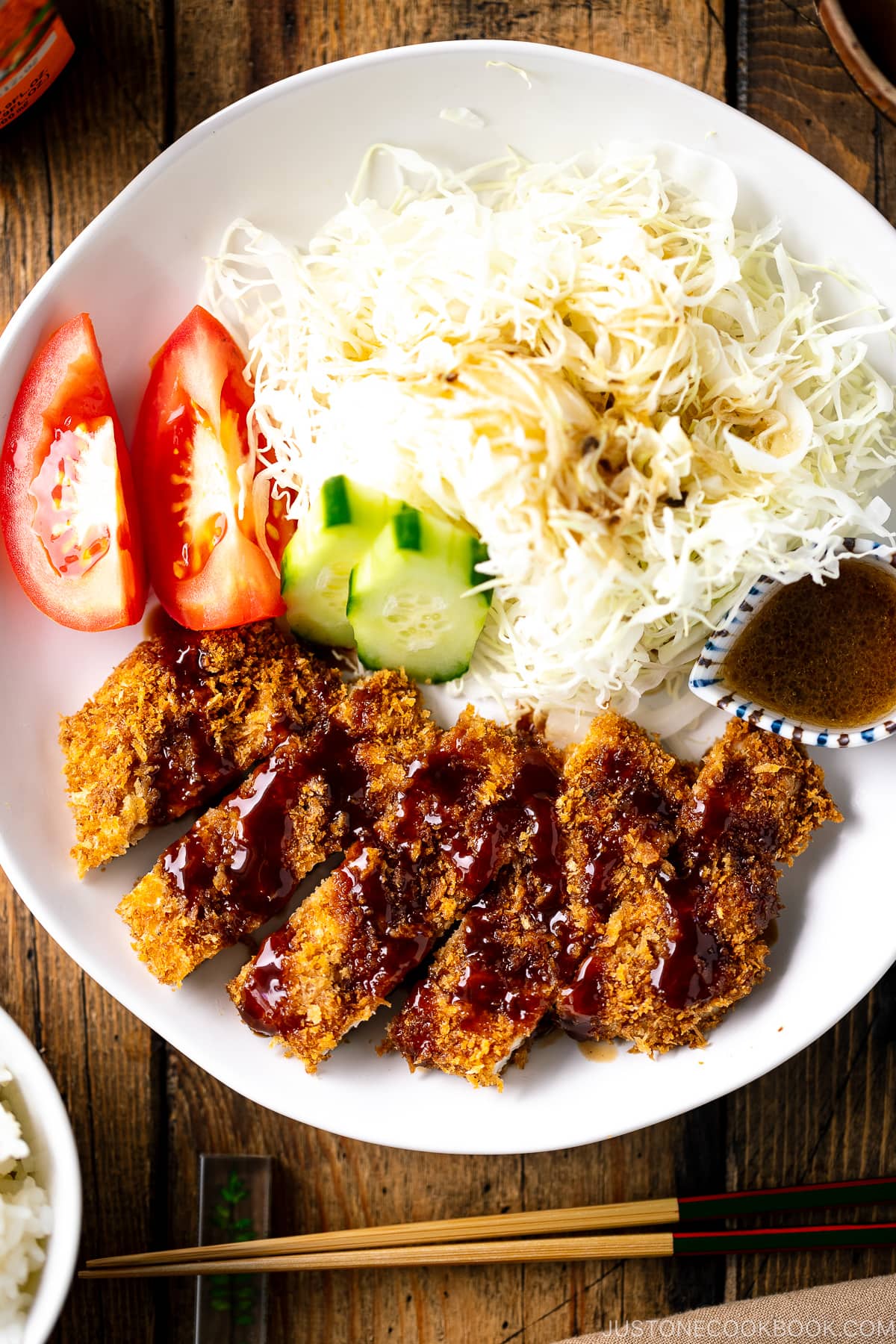
Ingredients for Baked Chicken Katsu
- Chicken breast
- Salt and pepper
- Flour (cake flour or all-purpose flour)
- Egg
- Panko (Japanese bread crumb)
- Cooking oil
How to Make Baked Chicken Katsu
- Toast the panko until golden brown and let cool.
- Butterfly the chicken breast (or use the Japanese “Kannon Biraki” method) and season it lightly with salt and pepper.
- Coat the chicken with flour, beaten egg, and toasted panko.
- Lay the chicken on a wire rack over a rimmed baking sheet.
- Bake at 400ºF (200ºC) for 25-30 minutes, or until internal temperature reaches 165ºF (74ºC).
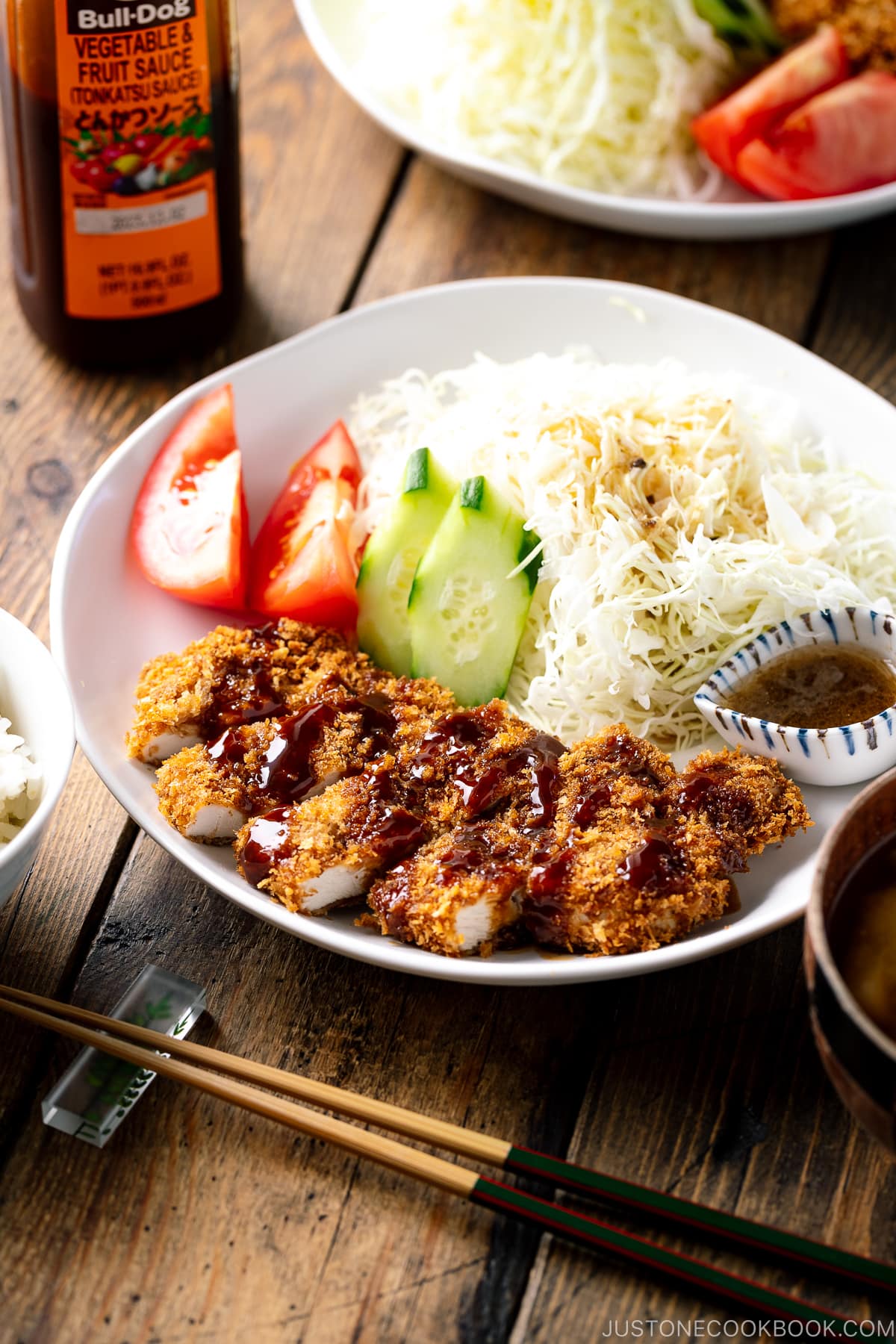
How to Butterfly the Chicken Breast (Kannon Biraki)
Chicken breasts are uneven and when you wait until the thick part of the chicken is cooked through, the thinner parts of the chicken are already overcooked, resulting in dry meat.
To prevent this from happening, it’s important to make sure the chicken breasts are even thickness. You can pound the meat with a mallet or you can butterfly (and pound) the chicken.
Typically, to butterfly the chicken breast, you would slice it in half horizontally. In Japan, we have a different way to butterfly the chicken, and this special cutting technique is called Kannon Biraki (観音開き).
Kannon Biraki – Japanese Cutting Technique
With a sharp knife, score the chicken breast lengthwise along the top center line, cutting about halfway through the thickness of the breast; do not cut completely through. Then, turn the knife parallel to the cutting board and slice the chicken breast from the center toward the left side (or the right side, if you’re left-handed) to make it evenly thin.

Stop before you cut all the way through the edge; then, open it like a book. Imagine we’re creating a French door here. Rotate the breast 180 degrees and butterfly the second side in the same manner from the center toward the left (if you hold the knife in your right hand), creating another “door.”

The term “Kannon Biraki” comes from the resemblance of the French-style hinged double doors that open to the front/back. This type of door was used for the Kannon Bodhisattva statue, and Biraki is the noun form of the word hiraku, meaning “to open” in Japanese.
Compared to the typical butterfly cutting technique, I find this Japanese butterfly technique more suitable for chicken katsu as it gives the typical “katsu” look. It’s up to you which butterfly methods you want to use.
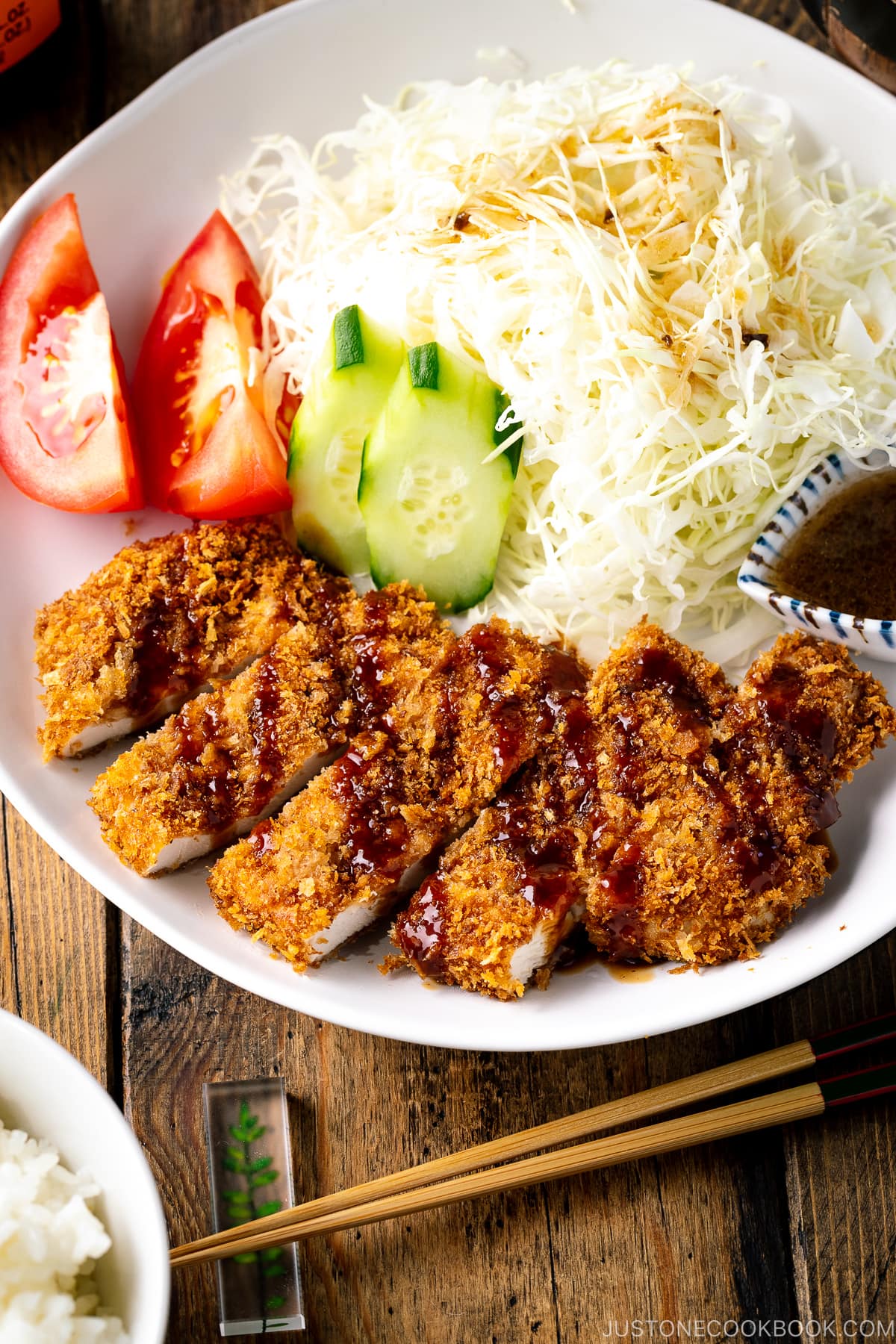
Tonkatsu Sauce for Chicken Katsu
Tonkatsu sauce (some non-Japanese refer it as katsu sauce) is specifically used for all the katsu dishes. It has a tangy and sweet flavor, akin to Worcestershire sauce. The famous brand is the Bulldog Tonkatsu, which can be found at Japanese and Asian grocery stores.
I also have a homemade tonkatsu sauce made with simple ingredients of Worcestershire sauce, ketchup, sugar, and oyster sauce.
What to Serve with Baked Chicken Katsu
Chicken katsu is often served with a shredded cabbage salad, tomatoes, sliced cucumber, homemade or store-bought salad dressing, and tonkatsu sauce. To complete the meal, enjoy it with steamed white rice along with miso soup.
Japanese deep-fried foods are always served with shredded cabbage on the same plate. You can thinly slice the cabbage yourself with a sharp knife or use this cabbage slicer that I highly recommend! Serve with your favorite salad dressing like Wafu Dressing or Sesame Dressing.
If you make extra, you can repurpose the cutlet and make Chicken Katsu Curry the next day!
Other Katsu Recipes

Wish to learn more about Japanese cooking? Sign up for our free newsletter to receive cooking tips & recipe updates! And stay in touch with me on Facebook, Pinterest, YouTube, and Instagram.

Baked Chicken Katsu
Ingredients
For Toasting the Panko
- 1¼ cups panko (Japanese breadcrumbs)
- 1 Tbsp neutral oil
For the Chicken Katsu
- 2 boneless, skinless chicken breasts (1 lb, 454 g)
- Diamond Crystal kosher salt
- freshly ground black pepper
- ¼ cup all-purpose flour (plain flour)
- 1 large egg (50 g each w/o shell) (you may need another egg)
- ½ Tbsp neutral oil
For Serving
- tonkatsu sauce (or make my homemade Tonkatsu Sauce)
Instructions
- Gather all the ingredients. Adjust an oven rack to the middle position and preheat the oven to 400ºF (200ºC). For a convection oven, reduce the cooking temperature by 25ºF (15ºC).

To Toast the Panko
- Combine 1¼ cups panko (Japanese breadcrumbs) and 1 Tbsp neutral oil in a frying pan.

- Toast the panko over medium heat, stirring frequently, until golden brown.

- Transfer the toasted panko into a shallow dish and allow to cool.

To Butterfly the Chicken
- We‘ll butterfly 2 boneless, skinless chicken breasts using the Japanese cutting technique called Kannon biraki (観音開き). With a sharp knife, score the chicken breast lengthwise along the top center line, cutting about halfway through the thickness of the breast; do not cut completely through.

- Then, turn the knife parallel to the cutting board and slice the chicken breast from the center toward the left side (or the right side, if you‘re left-handed) to make it evenly thin. Stop before you cut all the way through the edge; then, open it like a book. Imagine we‘re creating a French door here.

- Rotate the breast 180 degrees and butterfly the second side in the same manner from the center toward the left (if you hold the knife in your right hand), creating another “door.“

- Cut the butterflied breast in half down the center. Now you have two pieces. Butterfly the remaining chicken breast in the same manner. Then, using a meat mallet or rolling pin, pound the chicken cutlets to an even thickness, about ¼–½ inch (6 mm to 1.3 cm).

- Season both sides of the chicken cutlets with Diamond Crystal kosher salt and freshly ground black pepper.

To Bread and Bake the Chicken
- In a shallow dish, whisk together 1 large egg (50 g each w/o shell) and ½ Tbsp neutral oil. Place ¼ cup all-purpose flour (plain flour) in another shallow dish. Line up these two dishes along with the dish of toasted panko to prepare for breading the chicken. Tip: By adding oil, the meat and breading won’t detach from each other while cooking and the juice and flavor from the meat will not escape easily.

- First, dredge each chicken piece in the flour and shake off any excess. Next, dip the floured chicken piece into the egg mixture and coat well on both sides.

- Finally, coat the chicken with the toasted panko, pressing firmly to ensure the panko adheres to the chicken. Set aside. Repeat this process with the remaining chicken cutlets.

- Put the breaded chicken pieces on a wire rack placed over the rimmed baking sheet. Bake at 400ºF (200ºC) for about 25–30 minutes.

- When the internal temperature of the chicken reaches 165ºF (74ºC), it‘s done cooking. Remove from the oven and cut into ¾-inch (2 cm) slices.

To Serve
- Serve with a shredded cabbage salad (I use this cabbage slicer), tomato wedges, and cucumber slices, along with my Japanese Sesame Dressing or your favorite salad dressing. Drizzle tonkatsu sauce over the Chicken Katsu to enjoy!

To Store
- You can keep the leftovers in an airtight container and store in the refrigerator for up to 3 days and in the freezer for a month. To reheat, bake at 350ºF (180ºC) for 15–20 minutes for baked katsu that was thawed in the refrigerator overnight, or for 30 minutes if heating directly from frozen. Check that the inside is warm before serving.
Nutrition
Editor’s Note: This post was originally published on October 27, 2013. It’s been updated with new images and more helpful tips on September 26, 2022, and republished on July 12, 2023.







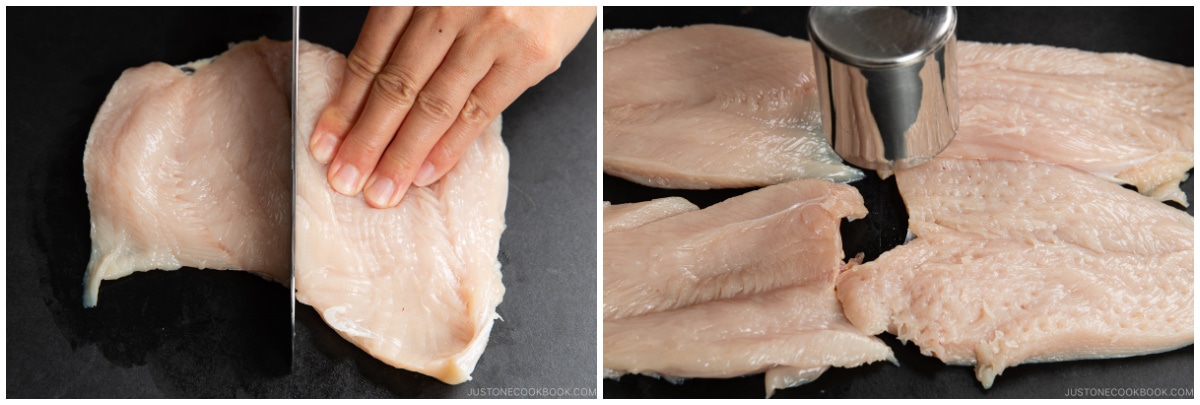






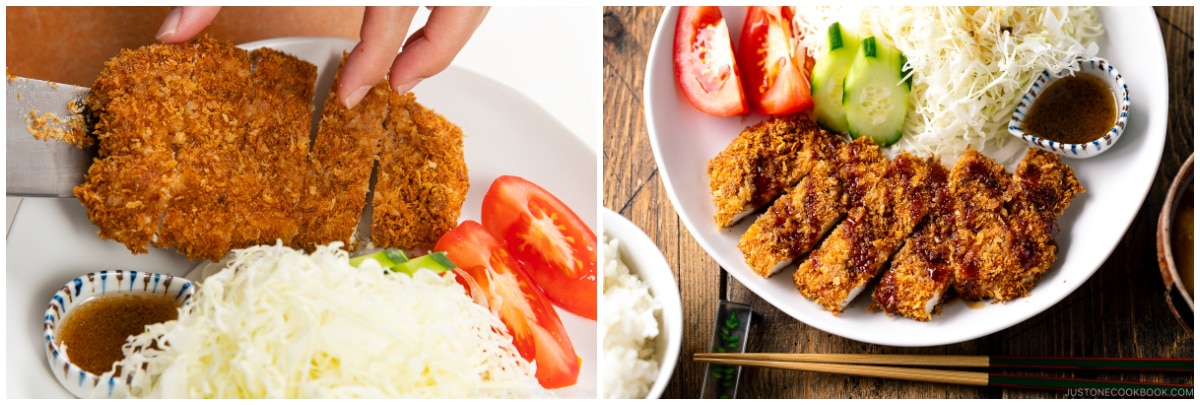












What an ingenious idea to toast panko with olive oil to a golden brown color! I was totally amazed at how baked chicken katsu could be so crispy and moist without leaving an oily smell in the house. Thank you for sharing this recipe.
Hi Ruby! Nami and JOC team are so happy to hear Nami’s tip worked very well for you, and you enjoyed the Chicken Katsu!
Thank you very much for trying this recipe and for your kind feedback!
Hi Namiko and Naomi (+team)! I have been following your blog for a while and I thought I’d stop by and say thank you for such amazing recipes. Tonight I made the baked chicken katsu (toasting the panko was genius) and served it with spicy edamame (yum!) on the side and I was just astounded by how delicious not to mention healthy everything turned out. Can’t wait to try out more Japanese recipes, thanks again! c:
Hi Anya! Thank you very much for trying Nami’s recipes and for your kind feedback!
Nami and JOC team are so happy to hear you enjoy the JOC site and enjoying many recipes!❤️ Your kind words meant so much to us! Thank you!
Just did the baked chicken katsu! It was super tasty, and the time- and effort-saving factor of baked option is beyond great ^_^ Thanks for the recipe and for the whole blog, it’s my top resource for Japanese cuisine for the last several months!
Hi Maria! Aww… Thank you very much for trying Nami’s recipe and for your kind feedback!
Nami and JOC team are so happy to hear you enjoyed our website and Baked Katsu recipe! Happy Cooking!
Best recipe using chicken breast that I’ve tried in a long time. My family loved it!
Hi Naoko! Thank you very much for trying the JOC recipe and for your kind feedback!
We are glad to hear your family loved this baked version!😊
An excellent and healthy recipe. I didn’t cut open the breasts, but bought the mallet for flattening out the chicken well instead so there was no need and they were very good. Well worth repeating. I also made the pork alternative, and whilst they were both very nice I think the chicken reheats a lot better than the pork if you plan on having left-overs.
Hi Nami, I have a questions about Panko substitutes. I have a severe wheat allergy, are their any acceptable Panko substitutes? or a way to create it? I have tried various things unsuccessfully. Thank you.
Hi Justina! You can use Kikkoman gluten-free Panko. It’s the Panko without the wheat.
Or you can use a food processor and make your own fresh Panko using your favorite bread.
And here is Nami’s Gluten-Free baked chicken Katsu recipe; https://www.justonecookbook.com/gluten-free-baked-chicken-katsu/
We hope this helps and you can enjoy Chicken Katsu!
I love katsu, but am deeply afraid of deep frying things. So this is my go-to all the time when I’m craving katsu, and it’s amazing. It’s almost impossible to mess up. Just remember to season the chicken breasts before breading- I forgot to do that one time and it tasted extremely bland.
Hi Aran! Thank you very much for your kind feedback!
We are glad to hear this baked version worked well for you! Thank you for trying this recipe.
Thank you for this recipe Nami, it turned out really delicious! I have some leftovers and I was wondering, how would you reheat this?
Gonna try some of your other katsu dishes soon, thank you for your recipes! 🙂
Hi Timothy, We are glad to hear you enjoyed this Baked Katsu! Thank you very much for trying this recipe.
To reheat, we recommend bake it at 375ºF (190ºC) on a wire rack until the inside is warm. We hope this helps!
Awesome recipe. I made it tonight. I made your baked tonkatsu recipe about 4 times in the past 6 months. One of my favorites. For this recipe I did not pound the chicken flat but made a pocket for some gouda cheese. Baked chicken cheese cutlet. It was really good. My Japanese wife really liked it. I upped the cooking time to 40 minutes since the chicken was thicker.
At my local supermarket Sprout’s they sell squid steak (10 cm x 10 cm x 1 cm. Next time I will try baking the squid steak using your baking method for cutlets. Might try some baked cod using this method and top it with some homemade tartar sauce.
Hi Jim, Thank you very much for trying this recipe and sharing your cooking experience with us! Wow, melted Gouda cheese in the crispy Baked Chicken Katsu sounds so yummy! Squid steak or Cod also sounds good and made us hungry!😆 Thank you for sharing your ideas!
Can’t wait to try this tonight!! Is there a reason why you use the sogigiri technique for the fried katsu version but butterfly and pound the baked version? The single chicken breast I bought is almost 1.5 lbs, so I was thinking it might be easier to slice off what I need for the two of us sogigiri style than to try to butterfly this monster chicken and only use half of it.
Hi Anna, Sure! You can do that. Please adjust the cooking time for your size of the chicken.
The Fried Katsu version is how Nami’s mom prepared, and the Baked version is more like a western-style Crispy Chicken. However, Sogigiri cuts would work well for this baked version. Thank you very much for trying this recipe!
Thanks for the healthier baked alternative. It tastes great!
Hi Sin, We are glad to hear you enjoyed this Baked version of Katsu! Thank you very much for trying this recipe and for your kind feedback.
This was great. It also works with tofu. I made it with both and served it with vegetable curry and rice. My family loved it.
Hi Eden, Thank you very much for trying this recipe! We are so happy to hear you and your family loved this dish!
Sorry if this has already been asked. How long would you cook it in a convection oven on a wire rack? Thanks!
Hi Lily, Baking time is about 25-30 minutes. (Step 4) If you are using a convection oven with a fan, don’t forget to reduce the oven temperature by 25F! (for this recipe, 375F) We hope this helps!
Hi, after baking, why is the bottom sometimes wet and not crispy?
Hi Jacqueline,
Thank you for trying this recipe!
Did you use a wire rack, as Nami mentioned in this recipe? During the baking, the chicken’s moisture builds up, and it will not be crispy if you use a baking sheet.
We hope this helps!
Hi Naomi!
Thank you for this recipe, it became a favorite here! My boyfriend calls it “magic chicken” as it’s super simple and so much healthier and better than the fried version. It’s his new comfort food after a tiring day of work. He’s a chef and make delicious food, but he asks me to make this chicken almost every Saturday for dinner. Thank you so much! Love your blog and your other recipes too!
Hi Jenny!
Aww… Thank you very much! ♥️
We are so happy to hear you and your boyfriend enjoy this baked version.
Thank you for trying this recipe and for your kind feedback.